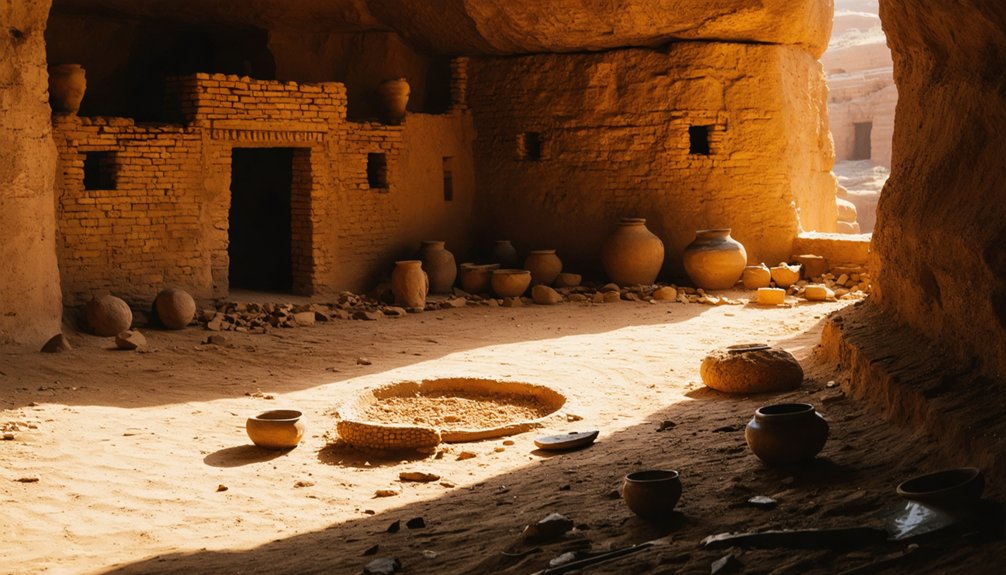To discover Native American civilizations, you’ll need to look beyond traditional remains. Study environmental clues, trace human footprints, and analyze engineering techniques. Consider climate impacts, trade networks, and recognize indigenous oral histories as valid sources. Utilize non-invasive geophysical imaging like GPR and magnetometry. Examine potential intercontinental contacts critically. Combine modern science with indigenous knowledge systems for a thorough understanding of these sophisticated societies that once thrived across North America.
Key Takeaways
- Utilize non-invasive geophysical technologies like ground-penetrating radar and magnetometry to map buried structures while preserving cultural sites.
- Examine environmental markers including pollen records, soil composition, and lake core samples to identify human settlement patterns.
- Integrate indigenous oral histories as valid historical evidence alongside archaeological findings for a more complete understanding.
- Look for evidence of advanced engineering techniques like flood-resistant designs and astronomical alignments in earthwork structures.
- Study trade materials like copper, turquoise, and seashells to trace extensive networks and cultural exchanges between ancient communities.
Look for Evidence Beyond Traditional Archaeological Remains
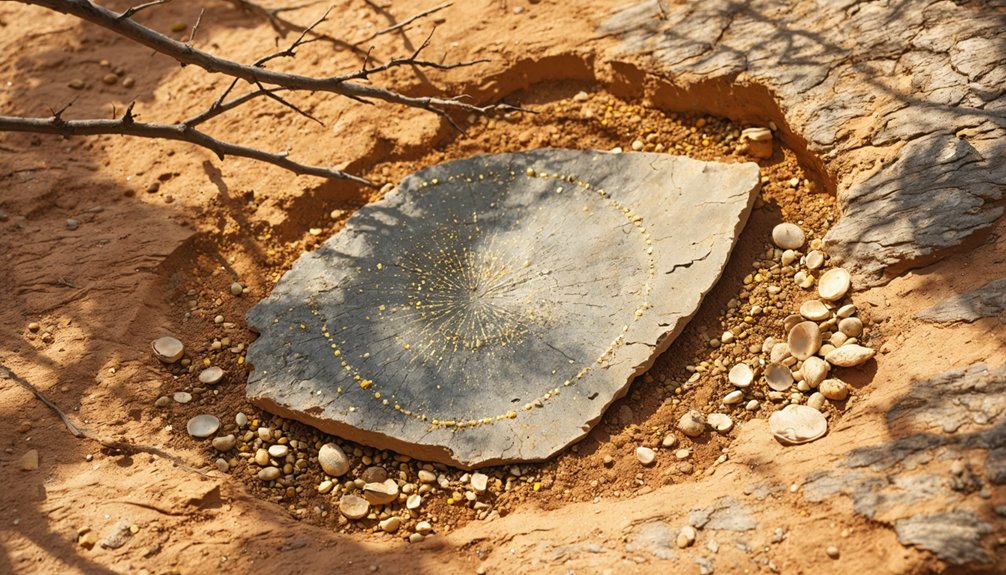
When investigating Native American lost civilizations, researchers must look beyond conventional archaeological remains to develop a thorough understanding of historical population patterns.
You’ll find that fecal stanol analysis from sediment layers provides direct evidence of human presence even when artifacts are scarce, revealing ancient landscapes through biological markers rather than physical objects.
Consider examining pollen records and plant remains to identify ecological footprints of agricultural activity, controlled burning, and land management practices.
These botanical indicators often persist when buildings and tools have vanished. Additionally, incorporate microbiological evidence that can illuminate dietary habits and migration patterns.
Ancient DNA analysis across vast distances has revealed rapid population movements between North and South America that were previously undocumented in archaeological records.
Don’t overlook the value of indigenous oral histories and early European contact records, which frequently preserve knowledge of settlements and cultural changes that might be invisible in the physical record. The recent study of Cahokia demonstrates how Native American presence continued well beyond the supposed collapse of Mississippian culture into the 1700s, challenging the “vanishing Indian” narrative.
Study Environmental Clues and Ecological Transitions
Environmental clues and ecological shifts offer powerful windows into Native American civilizations that traditional archaeological methods might miss.
Examine soil composition changes through microscopic analysis, revealing deliberate clay mixing that strengthened earthen structures at sites like Poverty Point. These engineering techniques created landscapes that resist erosion even millennia later.
Look for ecological impact signatures in lake core samples, where pollen records, charcoal remnants, and fecal stanols document population changes and land management practices.
Indigenous controlled burning created biodiversity mosaics that enhanced resource availability and wildlife abundance—effects still visible today.
Compare Perry Mesa’s lasting soil alterations with New England’s minimal pre-colonial ecological changes to understand different intensities of land use.
The sophisticated terracing techniques used by ancient cultures at Perry Mesa around 1275 CE demonstrate advanced water management strategies critical for agricultural adaptation to harsh environmental conditions.
Recent research across New England revealed that Native Americans had minimal regional impact on landscapes before European colonization, contrary to previous assumptions about their environmental manipulation.
Follow the Footprints: Human Trace Evidence
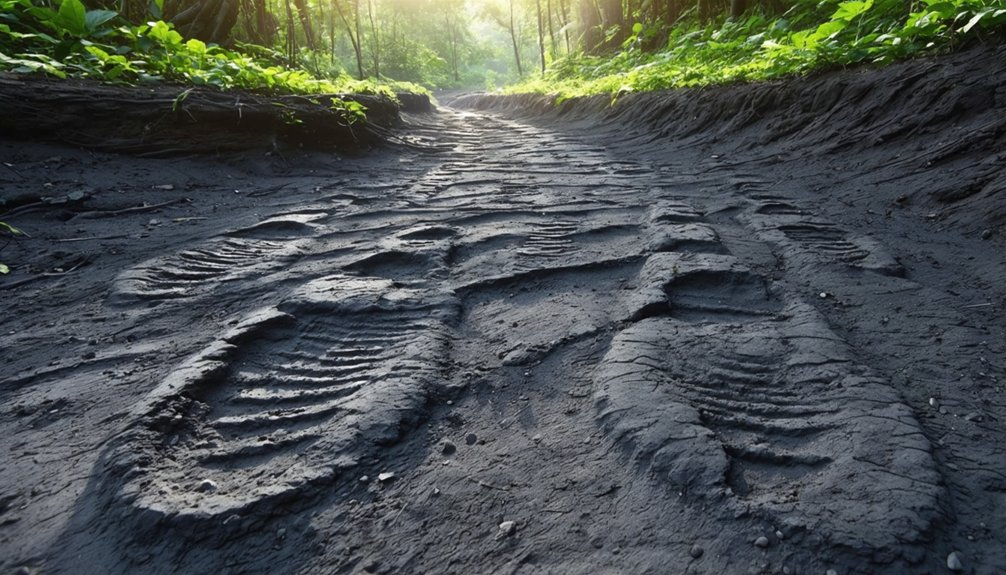
You’ll find ancient stories preserved in fossilized footprints at sites like White Sands, where 23,000-year-old human tracks coexist with megafauna impressions.
These trackways provide unequivocal evidence of human presence in the Americas during the Last Glacial Maximum, revealing interactions between early inhabitants and now-extinct animals like mammoths and dire wolves.
Carbon dating of organic materials in the same sediment layers has established reliable chronologies, allowing archaeologists to reconstruct human behaviors and movement patterns across prehistoric landscapes. The footprints were primarily made by teenagers and children, suggesting important social dynamics in early human communities. Similar to White Sands findings, advanced engineering skills are evident at sites like Poverty Point in Northern Louisiana, dating back over 3,000 years.
Ancient Stories Revealed
The preservation of ancient footprints at White Sands National Park offers unprecedented insights into human presence in the Americas during the Last Glacial Maximum, with carbon-dating confirming these tracks are between 21,000 and 23,000 years old.
When you examine these footprints, you’re revealing ancient narratives that challenge conventional migration theories. These imprints reveal interactions between humans and extinct megafauna, providing tangible connections to our cultural heritage long before previously accepted timelines.
Genetic evidence from ancient remains supports this earlier arrival, with analyses identifying lineages that split from modern Native Americans approximately 20,000 years ago.
You’ll discover that these ancient stories aren’t just preserved in bones and footprints but also in microscopic evidence like fecal remains, which have reconstructed demographic patterns and lifestyle changes spanning thousands of years across North America.
Behaviors Across Time
When researchers examine ancient human trace evidence across North America, they’re uncovering behavioral patterns that span millennia and challenge conventional understanding of prehistoric population dynamics.
Fossilized footprints at White Sands National Park reveal humans and megafauna sharing landscapes 23,000 years ago, demonstrating cultural adaptations to Ice Age environments.
- Trace evidence shows sophisticated environmental resilience through engineered earthworks mixing specific soil types.
- Fecal stanols analysis reveals human presence where traditional archaeological evidence is scarce.
- Controlled burning patterns indicate deliberate landscape management across generations.
- Footprint preservation in seed-bearing sediments enables precise environmental reconstruction.
- Settlement patterns at sites like Poverty Point demonstrate complex social organizations despite hunter-gatherer economies.
These markers of human behavior provide critical insights where conventional artifacts might be absent, revealing indigenous innovation across changing climatic conditions.
Understand Advanced Engineering Techniques in Ancient Earthworks
You’ll find the ancient earthwork builders mastered soil mixing techniques that modern engineers struggle to replicate, using precise ratios of clays, silts, and sands to create structures that have withstood centuries of erosion.
Their flood-resistant design principles incorporated rapid construction methods where layers were added without pauses, preventing weathering between construction phases and ensuring structural integrity even in high-rainfall regions. The remarkable precision and intentional design of these earthworks allowed them to maintain astronomical alignments over thousands of years. This extraordinary achievement challenges traditional assumptions, as these structures were built by hunter-gatherers who accomplished this feat around 3,400 years ago without modern tools or domesticated animals.
The monumental scale calculations required moving an estimated 140,000 dump truck loads of earth without mechanical assistance, demonstrating advanced planning capabilities that contradict simplistic views of hunter-gatherer societies.
Soil Mixing Mastery
Ancient Native American engineers developed three remarkable soil mixing techniques that modern construction science has yet to fully replicate.
When you examine these earthworks, you’ll discover precisely calculated material ratios combining clays, silts, and sand that created virtually indestructible structures. Their soil composition secrets mirror the sophistication of Roman concrete without modern tools. The earthworks represented communal effort requiring significant coordination among small populations who didn’t live in settled villages. These massive structures were likely designed as gathering spaces for spiritual ceremonies rather than permanent settlements.
- They created recipe-based mixtures for ideal structural integrity
- Different soil types were strategically placed for both function and aesthetics
- Red clay formed exterior surfaces while yellow clay lined interiors
- Construction occurred in rapid “lifts” without pauses between layers
- Color-differentiated soils served ceremonial purposes when illuminated by sunlight
This advanced knowledge enabled moving 140,000 dump truck loads of dirt by hand 3,500 years ago, creating monumental works that combined engineering brilliance with spiritual significance through ancient mixing techniques.
Flood-Resistant Design Principles
Although often overlooked by modern engineers, Native American flood-resistant design principles demonstrate sophisticated hydrological understanding that predates modern flood management by millennia.
You’ll find earthwork design carefully aligned with natural topography, especially in flood-prone regions along the Ohio, Mississippi, and Little Miami River valleys.
Examine how structures like Fort Ancient strategically position walls up to 23 feet high along bluff contours, creating natural barriers against flooding.
When investigating these sites, notice the integration of swales and diversion channels that capture and redirect water away from critical structures.
The terracing techniques break water flow on slopes, while clay-lined ponds serve as retention features.
Multiple gateways in earthworks allow controlled water passage, preventing pressure buildup during floods—a practical flood management solution that honored both spiritual beliefs and environmental safety.
Monumental Scale Calculations
When we examine the engineering feats of Native American earthworks, the monumental scale calculations reveal mathematical and logistical expertise that challenges modern assumptions about pre-contact technologies.
You’re witnessing evidence of sophisticated planning that moved earth equivalent to 140,000 modern dump truck loads—all without wheels or draft animals.
The monumental engineering at sites like Cahokia and Poverty Point demonstrates precise mathematical knowledge and resource management capabilities:
- Platform mounds reaching 100+ feet in height with multi-acre footprints
- Earthworks constructed in rapid, continuous lifts showing no weathering between layers
- Geometric precision in creating circles, squares, and serpentine forms spanning miles
- Calculated soil mixture ratios enhancing structural integrity and erosion resistance
- Alignment with celestial events requiring advanced measurement techniques
These earthworks construction projects spanned generations, indicating sustained knowledge transfer and cultural commitment to monumental architecture.
Consider Climate Change and Population Movement Patterns
Throughout history, climate shifts have profoundly influenced Native American settlement patterns, often triggering dramatic population movements and cultural adaptations. The Anasazi‘s dramatic change from farming villages to cliff dwellings in the mid-1200s exemplifies how climate impact can force radical lifestyle changes.
You’ll find evidence of these migrations by examining tree-ring data, which revealed how populations expanded in central Arizona during wetter 1300s periods.
When investigating lost civilizations, analyze how communities responded to environmental stressors. The Perry Mesa inhabitants, for instance, modified their landscape to create sustainable ecosystems that persist today.
These migration patterns weren’t random—they represented calculated moves toward environments that could support farming communities. By tracking these climate-driven relocations, you’ll develop deeper insights into why thriving cultures suddenly abandoned settlements after centuries of occupation.
Analyze Cultural Continuity After Apparent Abandonment
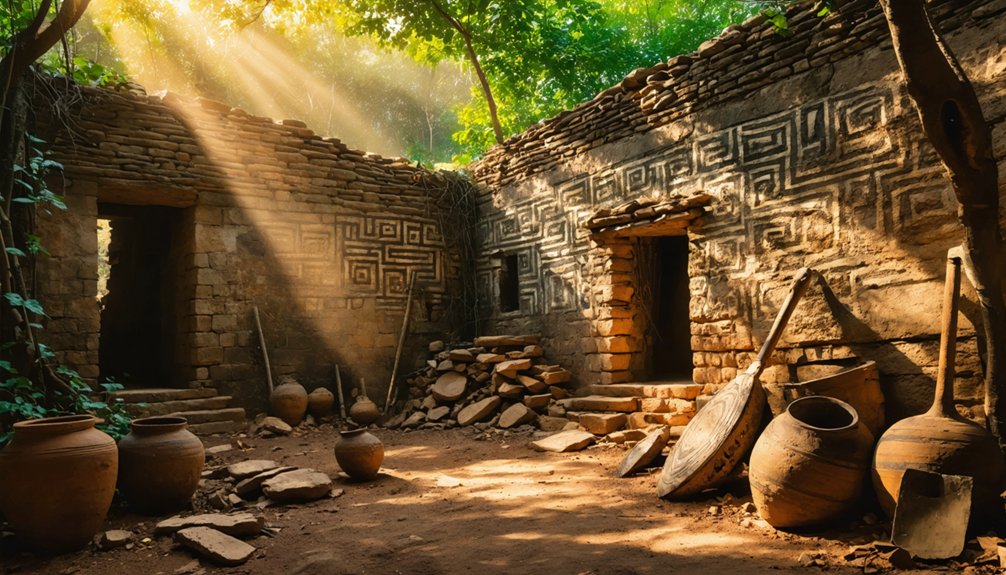
The apparent abandonment of Native American settlements often masks complex stories of cultural persistence that challenge archaeological narratives of disappearance.
When you examine sites seemingly “lost” to history, look for evidence of cultural resilience through continued regional presence rather than physical occupation of original structures.
Despite displacement, indigenous peoples maintained ancestral memory through:
- Oral traditions that preserved historical connections to abandoned sites
- Ceremonial practices conducted periodically at former settlements
- Artistic motifs and techniques that show continuity across generations
- Kinship networks that redistributed populations while maintaining cultural cohesion
- Place-based knowledge systems that incorporated “abandoned” locations into broader cultural landscapes
Explore Possible Trade Networks and Cultural Exchange
Ancient Native American societies developed far more extensive and sophisticated trade networks than most archaeological frameworks initially recognized. When investigating abandoned settlements, look for non-local materials like copper from the Great Lakes, turquoise from the Southwest, or seashells from coastal regions—evidence of long-distance exchange spanning thousands of kilometers.
You’ll find these trade networks weren’t merely economic systems but conduits for cultural exchange, transmitting belief systems, ceremonial practices, and technological innovations. Major hubs like Cahokia and Chaco Canyon facilitated these interactions through formal, direct relationships rather than simple down-the-line exchanges.
Sophisticated infrastructure, including the Chaco Road system, enabled these connections. When excavating, consider how seemingly local artifacts might reveal complex interregional relationships that sustained these societies for millennia, even through apparent abandonment phases.
Recognize Indigenous Knowledge and Oral Histories as Valid Sources
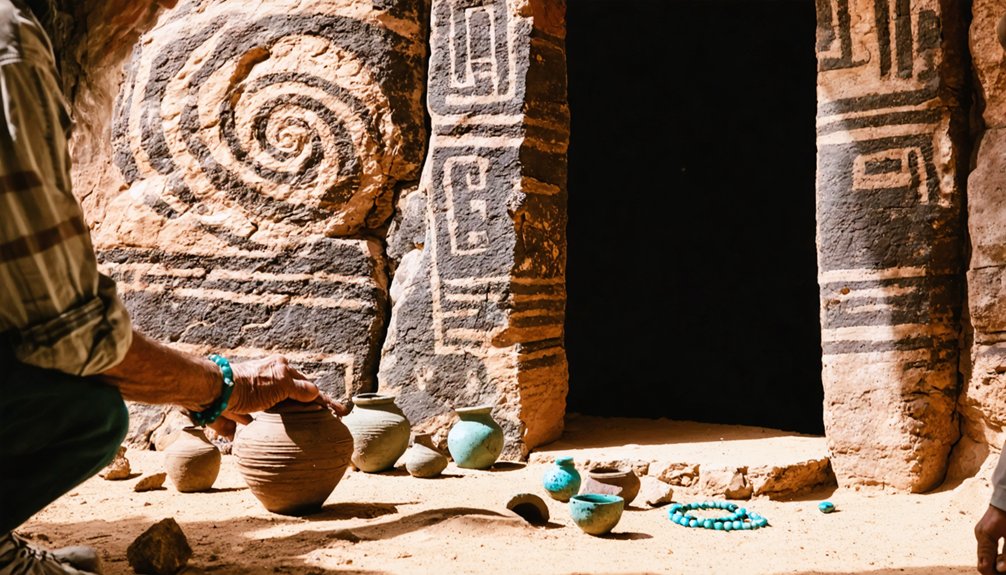
You’ll find that Indigenous oral histories provide critical insights into ancient civilizations that archaeological methods alone can’t reveal, as demonstrated by the validation of Native American accounts of the Missoula Floods through scientific evidence.
When you honor community storytellers as authorities and incorporate their knowledge systems into research frameworks, you transform archaeology from a colonial practice into a collaborative one that respects Indigenous epistemologies.
Your research becomes more all-encompassing when you acknowledge that knowledge exists beyond academia, as evidenced by cases where tribal oral traditions have successfully guided archaeological discoveries and received legal recognition in establishing cultural continuity.
Honoring Community Storytellers
While Western academic traditions have long privileged written documents as primary historical sources, Indigenous oral histories represent equally valid—and often more nuanced—repositories of knowledge that deserve recognition in scholarly discourse.
When engaging with community storytellers, approach with respect and humility, recognizing their role as knowledge keepers.
- Prioritize ethical storytelling by obtaining explicit consent before recording narratives
- Collaborate with tribal representatives who serve as official contacts for archival materials
- Acknowledge storytellers as historians, not merely “subjects” of research
- Build relationships based on trust and mutual respect before requesting knowledge sharing
- Follow community protocols for handling culturally sensitive information
Decolonizing Archaeological Methods
For decades, archaeological practices have perpetuated colonial power structures by privileging Western scientific methods while marginalizing Indigenous knowledge systems.
To decolonize your approach, you must recognize oral traditions as valid historical evidence, equal to written documentation.
When investigating Native American sites, integrate Indigenous perspectives through collaborative research with community members.
Challenge the notion that Western scientific standards represent the only legitimate path to understanding. Instead, embrace methodological pluralism that values multiple ways of knowing.
Implement co-curation practices where Indigenous communities participate in interpreting findings and controlling their cultural heritage.
Remember that NAGPRA and other federal laws now require consultation with Native communities, acknowledging oral histories as essential evidence for identifying ancestral remains and artifacts.
This shift isn’t just ethical—it produces richer, more accurate archaeological narratives.
Knowledge Beyond Academia
Despite centuries of academic dismissal, Indigenous oral histories now receive growing recognition as legitimate historical sources with demonstrable accuracy and reliability.
When researching Native American civilizations, you’ll discover that tribal knowledge extends beyond academia’s traditional boundaries, offering insights that have repeatedly proven accurate when tested against scientific methods.
- Geological evidence corroborates oral traditions about the Missoula Floods from thousands of years ago
- Archaeological findings at White Sands validate oral accounts of pre-Clovis habitation
- Tlingit oral tradition successfully guided researchers to rediscover ancient sites
- Winter counts serve as meticulous historical records maintained by designated keepers
- Multiple tribes’ oral traditions accurately describe geological events from the distant past
Utilize Non-Invasive Geophysical Imaging Technologies

When archaeologists seek to uncover Native American lost civilizations without disturbing sacred or culturally sensitive sites, non-invasive geophysical imaging technologies offer revolutionary solutions.
These geophysical techniques provide thorough archaeological mapping while preserving site integrity.
Non-invasive geophysical techniques enable detailed archaeological discovery while honoring and protecting sacred Native American sites.
You’ll find three primary methods particularly effective: electrical resistivity tomography (ERT) detects subsurface layers up to 8 meters deep; magnetometry identifies subtle magnetic anomalies from hearths and human activity; and ground-penetrating radar (GPR) creates detailed 3D visualizations of buried structures.
By integrating these approaches, you’ll obtain a more complete picture of subsurface features.
These technologies greatly reduce research costs while minimizing disturbance to culturally significant areas.
They enable you to target high-potential locations for focused investigation and expand research beyond traditional cave sites to open landscapes, offering a more thorough view of Native American civilizations.
Examine Potential Evidence of Intercontinental Contact
The question of pre-Columbian intercontinental contact beyond the well-established Bering migrations presents a complex archaeological puzzle with evidence that remains largely inconclusive.
When examining potential ancient migrations, you’ll need to distinguish between confirmed genetic back-migration across the Bering Strait and more speculative transoceanic theories.
- Focus on genetic evidence showing Native American DNA in Siberia dating back 5,000 years
- Consider the limitations of craniometric studies from places like Mocha Island, Chile
- Evaluate linguistic connections critically, such as sweet potato terminology similarities
- Recognize that most physical artifacts suggesting intercontinental contact belong to post-Columbian periods
- Differentiate between scientifically validated contact and theoretical models lacking archaeological support
The strongest evidence for intercontinental contact exists in genetic data confirming multiple migrations across the Bering region, with watercraft likely facilitating movement after the land bridge submerged.
Frequently Asked Questions
How Did Ancient Native Americans Calculate Astronomical Alignments in Their Structures?
You’ll find ancient Native Americans established solar alignments by positioning structures to mark solstices and equinoxes, while tracking lunar cycles through strategically placed observation points and architectural features that captured celestial movements precisely.
What Indigenous Plant Medicine Evidence Persists at Archaeological Sites?
You’ll find evidence of indigenous healing through pollen deposits, charred plant remains, DNA in dental calculus, and chemical residues that reveal plant rituals involving medicinal species like yarrow, cohosh, and poplar.
Were There Writing Systems Beyond Pictographs in Pre-Columbian North America?
You’ll find true writing systems primarily in Mesoamerica, where Maya, Aztec, and Mixtec ancient scripts combined logograms and phonetic elements. Outside this region, North American communication methods generally relied on pictographic and symbolic systems.
How Did Native Populations Adapt During the Little Ice Age?
You’d marvel at Plains tribes’ double-layered tipis, enhancing climate resilience during the Little Ice Age. They packed snow around bases, hung insulating liners, and developed communal resource management systems that preserved freedom while ensuring survival.
What Role Did Women Play in Ancient Native American Settlements?
You’ll find women held extensive power beyond gender roles, controlling agriculture, political appointments, and resource distribution. Their cultural significance extended to spiritual leadership and economic production—a stark contrast to European patriarchal systems.
References
- https://news.berkeley.edu/2020/01/27/new-study-debunks-myth-of-cahokias-native-american-lost-civilization/
- https://scitechdaily.com/new-evidence-americas-first-civilization-was-made-up-of-sophisticated-engineers/
- https://news.arizona.edu/news/earliest-evidence-human-activity-found-americas
- https://nysm.nysed.gov/research-collections/archaeology/native-american-archaeology
- https://www.nps.gov/articles/000/archeology-this-month-native-american-heritage.htm
- https://en.wikipedia.org/wiki/Pre-Columbian_transoceanic_contact_theories
- https://stories.tamu.edu/news/2015/07/21/study-confirms-first-americans-came-before-clovis/
- https://www.science.org/content/article/ancient-dna-confirms-native-americans-deep-roots-north-and-south-america
- https://www.youtube.com/watch?v=6_3SwV_I_D4
- https://www.the-scientist.com/new-evidence-complicates-the-story-of-the-peopling-of-the-americas-69928
